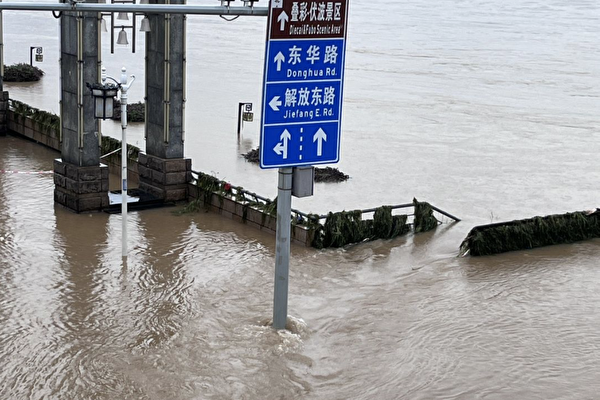In recent days, southern China has been hit by heavy rain and flooding. The Li River in Guangxi has overflowed, causing flooding in Guilin train station. Official reports label the flood as a once-in-30-years event. Some residents interviewed mentioned that while heavy rainfall is a contributing factor to the flooding, the discharge from the reservoirs is also to blame. The outdated reservoirs built during the Mao era have now become sources of flooding. State media has acknowledged the connection between rising river levels and reservoir discharge.
According to a report by China Central Television on June 20th, the water level of the Li River in Guilin, Guangxi, has been steadily rising. At 12:55 am on the 20th, the water level at the Guilin hydrological station reached 148.88 meters, surpassing the warning level by 2.88 meters, marking it as a flood of a magnitude not seen in over 30 years.
In Guilin city, the rising Li River water has overflowed onto the streets, causing flooding in more than 20 areas and blocking traffic in over 10 locations.
The previous day, a report by China Central Television mentioned that “due to continuous heavy rainfall and the successive discharge of upstream reservoirs of the Li River,” major rivers in Guilin, Guangxi, experienced rapid rises in water levels on June 19th. According to hydrological and meteorological data, as of 5:00 pm on the 19th, the water level in Guilin had reached 148.55 meters, surpassing the record 148.4 meters during the severe Li River flood in 1998 by 2.55 meters, marking it as the largest flood in Guilin since 1998.
Mr. Wang, a resident of Guilin, Guangxi, mentioned on June 20th that “yesterday the water rose to about 3 meters deep, and the road in front of the Nan Shui Village was flooded completely, making it impassable.”
Reports from Chinese media outlets such as Sina and Zonglan News on June 19th showed flooded areas from Cangshan Bridge to Jingpingshan in Guilin, Guangxi. Severe urban waterlogging was reported in the main city area with several tourist spots being forced to close, multiple bus routes suspended, and many schools announcing closures.
Guilin train station was submerged, with water flooding into the waiting area. The popular “Six Horses” scenic spot under the Li River bridge in Guilin city was completely submerged, making it unrecognizable.
Mr. Wang and Mr. Lin, residents in the Qixing district of Guilin city, expressed their concerns to the Chinese media. They noted that this year’s flooding may be even more severe than that of 1998. Floodwaters from the Xindong River, a tributary of the Li River, have flooded ground-floor shops with surrounding areas experiencing power outages. Mr. Lin mentioned the city center being inaccessible, with water levels reaching chest height at the deepest points.
Videos depict Guilin’s streets transformed into waterways, with residents navigating in boats for transportation.
According to an official weather forecast from Guangxi Meteorological Bureau on June 19th at around 6:00 pm, rainfall in Guangxi is expected to weaken in the coming days, though heavy rain is still forecasted in northern Guilin on the night of the 20th to the day of the 21st.
Official reports from Guangxi have focused on the meteorological causes of the excessive rainfall during this disaster. However, China Central Television mentioned that the impact of continuous heavy rainfall and the discharge from upstream Li River reservoirs played a significant role.
Mr. Wang from Guilin emphasized the impact of continuous heavy rain as a primary cause of the flooding. He also highlighted the issue of reservoir discharge, stating, “In the past, many floods were caused by the reservoir reaching its limit and releasing water at high volumes. This time, reservoir discharge should also be a factor. The natural cause is heavy rain, and there were several warnings issued prior.”
According to the Guilin Daily, Guilin city has a total of 448 reservoirs of various types. The four largest reservoirs upstream of the Li River include the Fuzi Kou Reservoir, Chuanjiang Reservoir, Xiaorongjiang Reservoir, and Qingshitan Reservoir.
Mr. Wang, who has studied the history of the Chinese Communist Party, pointed out the negative impact of older reservoirs built during the Mao era. He stated, “The operation of old reservoirs over the years, constructed under insufficient conditions at the time, required continuous reinforcement. The investment needed for the reinforcement of those dams would cost several times more than the original construction. If a dam were to collapse, people downstream would be inundated. So, these dams built hastily at the time often become sources of flooding.”
State media has mentioned the “urgent call for central emergency relief materials to support Guangxi.” However, Mr. Wang mentioned that while some disaster-related supplies have been provided, the Chinese Communist Party government has never provided relief or compensation to the affected people. The maximum assistance includes sending text messages to warn of floods, ensuring safety, and possibly using rubber boats to rescue people. “That’s the extent of their help. Economically assisting people to get through difficult times seems to be something the Chinese (Communist) government has never done.”
“Because all the government expenditures in China are used to maintain officials, they will not be used for the welfare of the people. They would rather spend large sums internationally than provide basic welfare to the people. This is the inhumane nature of this regime,” he stressed.

